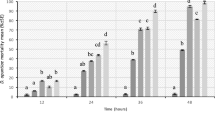Abstract
Residue persistence of beta cyfluthrin and imidacloprid on mango was carried out after giving spray application of the combination formulation, beta cyfluthrin 9% + imidacloprid 21% (Solomon 300 OD) 3 times at the fruit formation stage. The treatments were, untreated control, standard dose of 75 g a.i. ha−1 and double dose of 150 g a.i. ha−1. Initial residues of beta cyfluthrin on mango fruits were 0.04 and 0.12 mg kg−1 from treatments at the standard and double doses, respectively. The residues dissipated with the half-life of 2.4 and 2.6 days and persisted for 5 days only. Initial residues of imidacloprid on mango fruits were 0.14 and 0.18 mg kg−1 from treatments at the standard and double doses, respectively. Imidacloprid residues degraded with the half-life of 3.06 and 4.16 days, respectively and persisted for 10 days. Mature mango fruits at harvest were free from residues of both insecticides. A safe pre-harvest interval of 8 days is recommended for consumption of mango fruits after treatment of the combination formulation.


Similar content being viewed by others
References
Anonymous (2006) Mangoes in India. http://www.horticultureworld.net/mango-india2.htm#DISEASES. Accessed 10 December 2010
Anonymous (2007) Joint meeting on pesticide residues: beta cyfluthrin, pesticide residues in food. FAO plant production and protection paper 228:169–225
Anonymous (2008) Mango pests. http://nhb.gov.in/bulletin_files/fruits/mango/man008.pdf. Accessed 15 November 2010
Dikshit AK, Pachauri DC, Jindal T (2003) Maximum residue limit and risk assessment of beta cyfluthrin and imidacloprid on tomato (Lycopersicon esculentum Mill). Bull Environ Contam Toxicol 70:1143–1150
Hoskins WM (1961) Mathematical treatment of loss of pesticide residues. Plant Prot Bull (FAO) 9:163–168
Indumathi N, Savithri P (2003) Efficacy of some insecticides against mango hopper complex. Indian J Plant Prot 31:114–115
Kumari ML, Singh SP, Kiran K, Singh SN (2008) Bio-efficacy of beta-cyfluthrin, lambda—cyhalothrin and imidacloprid against Earias vitella Fab. in okra. Annu Plant Prot Sci 16:21–24
Mandal K, Chahil GS, Sahoo SK, Battu RS, Singh B (2010) Dissipation kinetics of beta cyfluthrin and imidacloprid in brinjal and soil under subtropical conditions of Punjab, India. Bull Environ Contam Toxicol 84:225–229
Samanta A, Gosh A, Hembram TK, Patra S, Somchowdhury AK (2009) Efficacy of insecticides against mango hoppers and fruit yield. Annu Plant Prot Sci 17:225–274
Singh SB, Mukherjee I, Maisnam J, Kumar P, Gopal M, Kulshrestha G (2008) Determination of pesticide residues in IPM and non-IPM samples of mango (Mangifera indica). J Environ Sci Health B 43:300–306
Verghese A (2000) Effect of imidacloprid, lambdacyhalothrin and azadirachtin on the mango hopper. Idioscopus niveosparsus (Leth.) (Homoptera:Cicadellidae). VI international symposium on mango. Acta Horticulturae 502:733–736
Acknowledgments
The authors thank Director, IIHR, Bangalore and ICAR, New Delhi for providing the facilities for carrying out this study.
Author information
Authors and Affiliations
Corresponding author
Rights and permissions
About this article
Cite this article
Mohapatra, S., Deepa, M. & Jagadish, G.K. Behavior of Beta Cyfluthrin and Imidacloprid in/on Mango (Mangifera indica L.) . Bull Environ Contam Toxicol 87, 202–207 (2011). https://doi.org/10.1007/s00128-011-0310-3
Received:
Accepted:
Published:
Issue Date:
DOI: https://doi.org/10.1007/s00128-011-0310-3




